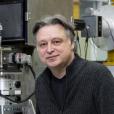
Tritium & other LSC
Accurate low level tritiated water (HTO) data is an essential tool for groundwater dating and understanding groundwater recharge processes.

Showing 261 - 280 of 518 results

Accurate low level tritiated water (HTO) data is an essential tool for groundwater dating and understanding groundwater recharge processes.
Macromolecular crystallography helps determine the atomic structure.

Sherry entered university, torn between the allure of science and the hands-on practicality of engineering. This lead her into the field of Material Science and Engineering.

Micro-Elastic Recoil Detection Analysis (µERDA) is used to reconstruct elemental maps from scanned raster points.
The first demonstration of reversible symmetry lowering phase transformation with heating.
Doping with transition metals produced stability in bismuth oxide.
Doping with transition metals produced stability in bismuth oxide.
Using the past to illuminate the future: Brothers collaborate on important science documentary for ABC TV

Accommodation Information
ANSTO contributes to major study on global warming by measuring methane and carbon monoxide trapped in ice.

X-ray fluorescence scanner is a powerful analytical tool for environmental studies.
A targeted radioactive infusion that is a game-changer in late-stage prostate cancer can also dramatically improve outcomes for patients in earlier stages of this disease, a Peter Mac-led study has shown.

New facility will greatly enhance Australia’s capability in stress engineering for industry
Understanding of micro-structure gained using X-ray scattering and spectroscopy.
With world-class experts in groundwater and major contributions in this area over two decades, ANSTO completed a major project report on Improving groundwater sustainability and renewability using isotope hydrochemistry in NSW for the Department of Planning and Environment (NSW) and National Water Grid earlier in the year.


This COVIDSafe Plan describes the actions that ANSTO will take to keep our staff, contractors and visitors safe and minimise the risk of the spread of COVID-19 infection.


As blood breaks down in the skin tissue, the colour of a bruise changes with time. As such, it may be used to find out information about the age of the bruise and hence a timeframe of when the incident that caused the mark took place.